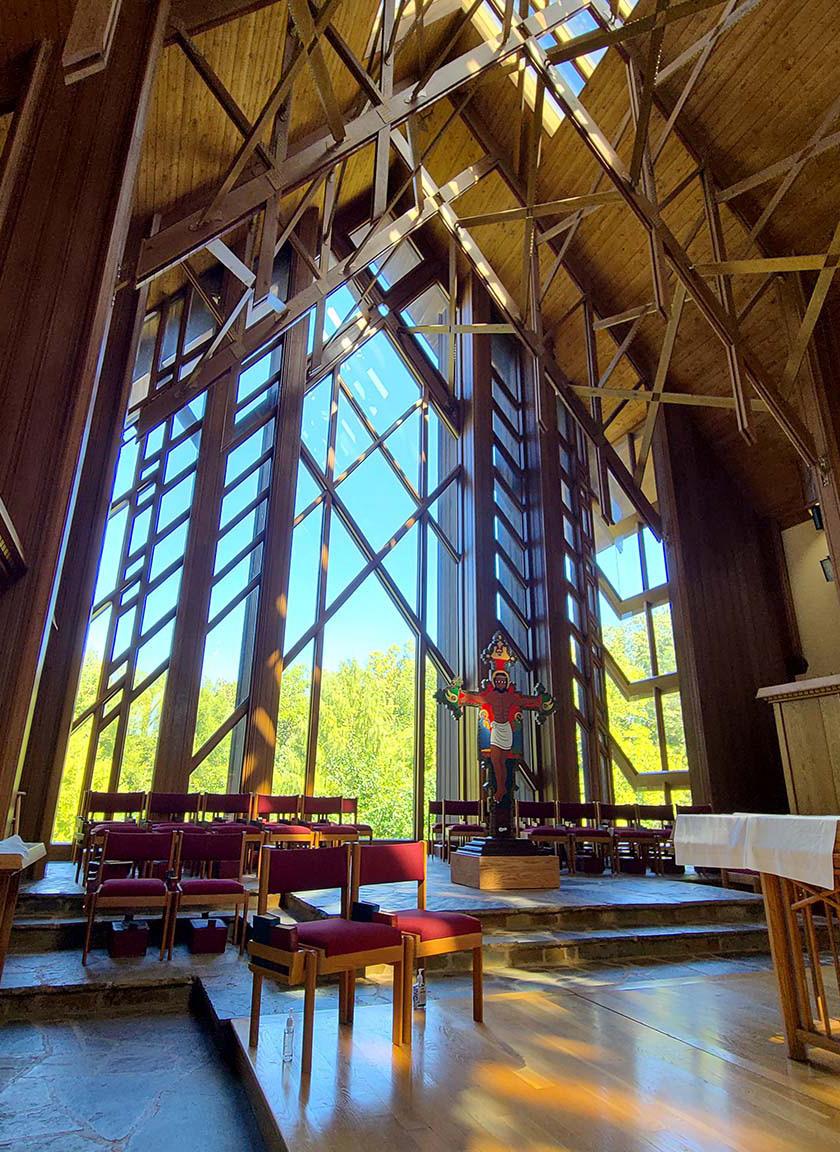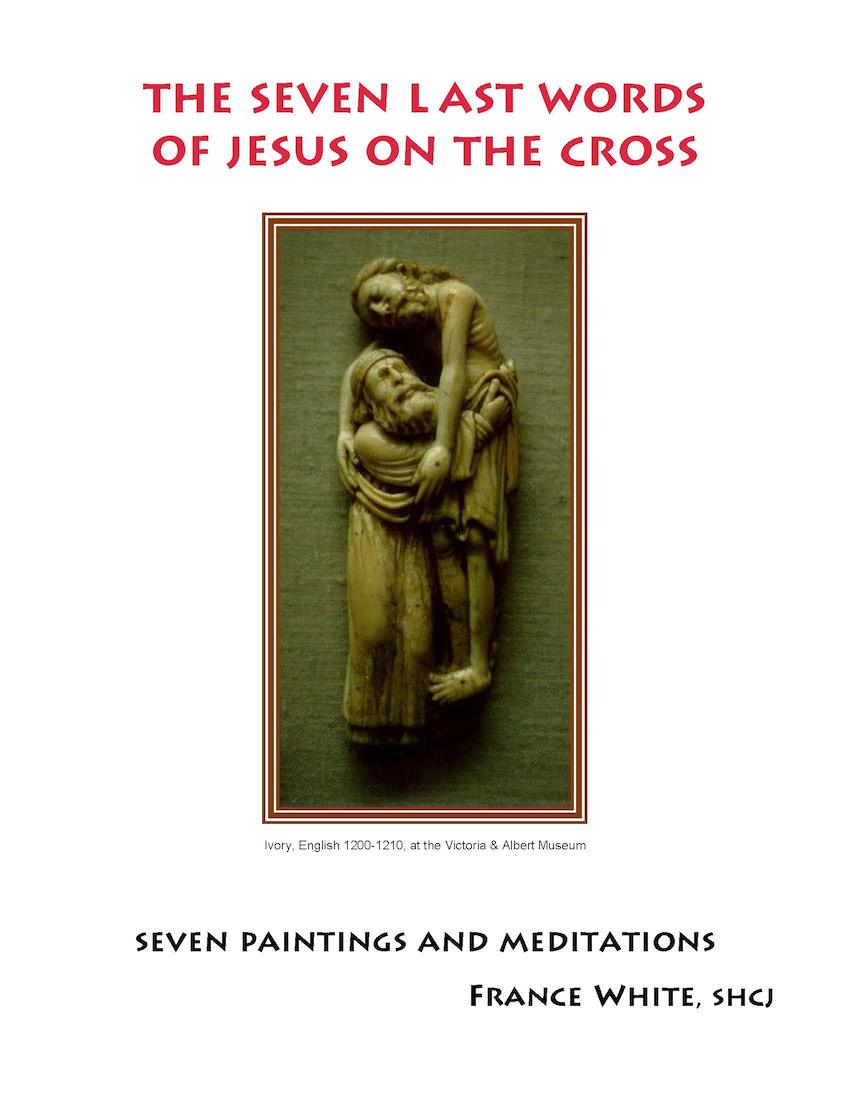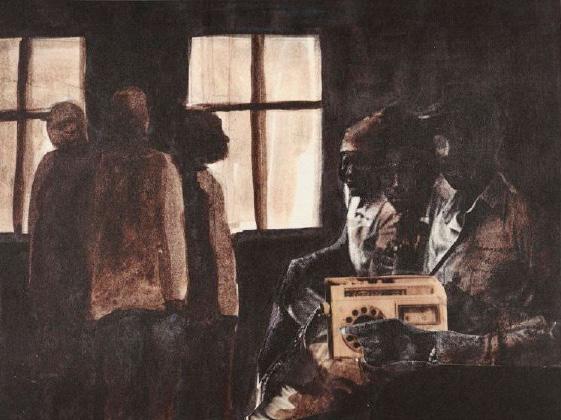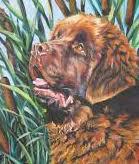CONTENTS—Presentation, Lent, Passover, Easter:
•A Love Full of Color, by France White, SHCJ—video of the story of painting a new crucifix for Mayfield Junior School of the HC Jesus in Pasadena, California
•Christ in Full Color—about the new crucifix painted by Laura James for Sewanee School of Theology to present Christ as a middle-eastern man, and repair for past racial injustices
• “Images of Faith & Suffering” from the Lithuanian culture and long experience of oppression: a photo of “The Hill of Crosses” and a sculpture of “The Worried Christ”
•The Seven Last Words of Jesus Christ—original paintings & meditations by France White, SHCJ
•Upside Down, a reflection by Brian Draper on the poem “Refugees” by Brian Bilston about the temtation of Christ in the desert
•Happy Passover!—some thoughts by Tobie Tondi on the Jewishness of Jesus, accompanied by the painting of “The Holy Family at Passover” by Laura James, with Passover music and the video story of Hallel

•Bi-lingual Prayer for the Feast of the Presentation (English & Spanish)
•A Trilogy of Poems inspired by the Presentation—”The Presentation by James Torrens, “A Poem for Candlemas by Christopher Villiers, “Wait and See” by Richard Bauckham
•What happened to the Dog?—an original poem, in English & Spanish, by Mary Hamilton about the dog involved in John Henry’s accident
•Music for the feast of the Presentation—”Christ Be Our Light,” “Song of Simeon,” “Ave Maria,” “Un Cantico Nuevo,” “You Send Forth Your Servant in Peace,” “We Are the Light,” “Madre del Silencio,” “Nunc Dimittis;” “Spanish Pavanne performed by Jenny Bullen, SHCJ on the recorder
Be sure to see the VIDEO of the NEW CRUCIFIX for Mayfield Junior School of the Holy Child Jesus in Pasadena, California.

When artist, France White, SHCJ, was asked to design a crucifix for the newly renovated chapel at this 92-year-old school she wanted to do something suitable for children, aged 5-14. So France chose to paint a resurrection cross in the style of the medieval crucifix that spoke to the young Francis of Assisi hundreds of years ago, calling him to rebuild the church, the body of Christ.
After four years of research and hard work in her garage studio, France has completed her task — wonderfully! And the crucifix will soon be installed in the school chapel, in memory of Sr. Mary Joel Scully, SHCJ, who taught in the school for many years.
In this 9-minute video, France tells her story of painting Christ on the cross surrounded by his many companions who are conversing together and enjoying the wonder of the resurrection. Click to view.

“My intention in painting this crucifix ... is for it to be a welcome to all who enter the chapel ... I desire that each one will feel a personal sense of belonging, will find a connection in the multi-racial, multi ethnic character, as imperfect as my renditions are — that each will find a part of themselves in the image of Jesus.”
France White, SHCJ
“A Love Full of Color” by France White, SHCJ RE-SOURCE #1 — February 2 – May 27, 2023
“Christ in Full Color” at Sewanee School of Theology



RE-SOURCE #1 — February 2- May 27, 2023
Sewanee University of the South is a liberal arts college in Sewanee, Tennessee. The university’s school of theology is rooted in the Anglican tradition and committed to preparing lay and ordained leaders for service to the church and world. For seminarians who study and live at the school of theology, the “Chapel of the Apostles” is regarded as “the real and symbolic heart of seminary life.”
 New crucifix created by artist Laura James and blessed by Bishop Tengatenga, at its dedication within the Chapel of the Apostles at the Sewanee School of Theology, September 27, 2022.
He is the image of the invisible God ... Col 1:15
New crucifix created by artist Laura James and blessed by Bishop Tengatenga, at its dedication within the Chapel of the Apostles at the Sewanee School of Theology, September 27, 2022.
He is the image of the invisible God ... Col 1:15
When the chapel was built in 2000, it featured a European-style crucifix with the body of Christ represented as a white, European man. Twenty years later the faculty unanimously recommended replacing the white crucifix with a new one both truer to the image of the historical Jesus and indicative of the University’s desire to make reparation for past racial injustices. “It was a radical and unexpected move. While a part of the larger picture of racial reconciliation at the University, the decision also acknowledged the distance many Christians feel from the depiction of Jesus as a white European.”
…. Led by Bishop James Tengatenga [of southern Malawi] a committee of students, alumni, and faculty discerned a vision for the new crucifix “that would better reflect Jesus’ historical identity as a Middle Eastern Jew.” https://theology.sewanee.edu/media/features/a-crucifix-of-color/

Ultimately, they commissioned Laura James to create the new crucifix. Of the details of her commission, James says, “They specifically asked me for Christ standing on the Cross, as opposed to slumping over the Cross. They also wanted a piece that was rendered in the Ethiopian Christian art style, with his eyes open and the tree of life on the back …. I thought it was brave to have a Black Jesus in a church represented that way. And not just any church, but a church that is on land that was given by a slave owner and which has such a strong connection with the Confederacy, and which is now used to train future clergy.”
https://theology.sewanee.edu/media/features/christ-in-full-color/

“I’m also working on a series of paintings about race and reparations …. To reveal why reparations are an act of justice …. I want us to elevate our consciousness and it’s time to do that. It’s time to come to common ground and work toward actually living while loving one another.”
See Laura James” presentation at https://vimeo.com/761590520
Laura James shows the Tree of Life on the back of the crucifix
In her new book, Why the Cross?, theologian Ligita Ryliškytė speaks of her Lithuanian cultural heritage and her personal experience of living in a country dominated first by the Russian Empire and later by the Soviet Union. Devotion to the cross and the image of “the worried Christ” gave her people comfort in their mourning, and strength to rebel against years of cruel oppression. She says:
“… reflecting on the cross seems to be in the blood of us, Lithuanian Catholics. The famous Hill of Crosses near Šiauliai, the many crosses along our roads, and, finally, the religious symbol par excellence of our country, the wooden figure of Christ shortly before his crucifixion, Rūpintojėlis (The Worried Christ, or The One Who Cares) speak for themselves. In the context of prolonged historical suffering, these symbols express the merging of religious and national affectivity and imagination.”

See“WhytheCross?”inUNDERSTANDINGINCARNATION

RE-SOURCE #1 — February 2 –May 27, 2027 — “Images of Faith & Suffering”—
“Images of Faith & Suffering”

Click to view & download booklet
“Upside Down” — A Reflection on a Poem RE-SOURCE #1 — February 2 – May 27, 2023



From the website of Brian Draper, journalist, writer and BBC host of Thought for the Day — https://www.briandraper.org/
“[This] poem …. reminded me of the direction of travel Jesus takes upon the Incarnational way; … The movement of the heart … turns the usual ‘top down’ approach to life on its head, and starts from the bottom instead. So make sure you get all the way to the bottom of the poem. Read it aloud, if you can
Refugees
By Brian Bilston
They have no need of our help
So do not tell me
These haggard faces could belong to you or me
Should life have dealt a different hand
We need to see them for who they really are
Chancers and scroungers
Layabouts and loungers
With bombs up their sleeves
Cut-throats and thieves
They are not
Welcome here
We should make them
Go back to where they came from
They cannot
Share our food
Share our homes
Share our countries
Instead let us
Build a wall to keep them out
It is not okay to say
These are people just like us
A place should only belong to those who are born there
Do not be so stupid to think that
The world can be looked at another way
(now read from bottom to top)
...”
The world can be looked at another way
The world can be looked at another way

Wow! Starting from the bottom makes the difference here — which, as I say, resonates for me with the Incarnation. I guess that’s so much of what the wilderness becomes about, for Jesus, when he shows up there — to show that the world can ‘be looked at another way’.
Jesus’ temptations, in particular, seem to cry out to be turned upside down, like the poem. Life is not about proving or defending yourself, but demonstrating God’s mercy; Jesus’ desire is not to gain all the kingdoms of the world, but to redeem and share Creation….
But even the idea of wilderness can turn upside down. We have our usual expectations of what it must be like: tough, stark, punitive, maybe; but that’s how the ego sees it. And to be fair, it needs to be a place beyond familiarity, to show us how familiar our temptations have become, hidden in plain sight.
For Jesus, above all it was a place to cultivate love, not survival skills. He entered with his Father’s words still ringing: ‘This is my son …’ And I love to think he let love carry him, ever deeper into God’s ways of seeing, and being.
 Brian Draper
Brian Draper
LISTEN: Music from the Time of Jesus, a 12 minute interview with the Antonio Vocal Arts Ensemble, a contemporary group that has researched and re-produced the music of Jesus’ time — https://www.npr.org/2003/04/20/1234688/music-from-the-time-of-jesus
So, even if today we call ourselves Christian and even further, Catholic Christians, we must never forget that our roots are in Judaism. Judaism is our heritage. You may not know many Jewish people or know much about Judaism but remember that Jesus’ ancestral roots and, therefore, our roots as followers of his, are Jewish.
And so, Jesus celebrated Passover with family and friends — the festival of deliverance from slavery in Egypt, the Exodus — a celebration that has continued through the ages, and in this year of 2023 will be observed from April 5-13.

The documents of Vatican II give us an image of Judaism as a wise old olive tree and we, gentiles, are wild branches that are grafted onto the old, wise tree and still getting nourishment from it.
Tobie Tondi, SHCJ
Psalms 113-118 are traditionally prayed at the Seder meal; they constitute the Hallel, the song of praise to God for the Exodus.
WATCH: What is the Hallel? — a 3 minute video explaining the history and contents of this great prayer of gratitude and praise — https://www.youtube.com/watch?v=Cyqm6tYyQoU
LISTEN: to boy soprano, Liam McCarthy, sing Chichester Psalm 23 by Leonard Bernstein — “The Lord is my Shepherd ...” https://www.youtube.com/watch?v=mbylWVS1Iyg&list=OLAK5uy_miF02iSTRymEkkYLJRe6hvBaooqQCK2Rk&index=2

In his gospel, John mentions the three Passovers that occurred during Jesus’ ministry.
• John 2:13 preceding Jesus’ cleansing of the temple
• 6:4 precedes the feeding of the 5000
• 11:55; 12:1; 13:1; 18:28, 39; and 19:14 before Jesus died, recorded by all four Gospel writers in conjunction with the Last Supper and his death.
Jesus was Jewish. He was born a Jew, he died a Jew; he lived his entire life as a follower of Judaism.
In this painting, artist Laura James depicts the family of Jesus gathered for the Seder meal to begin their Passover observance.
“Happy Passover!” — RE-SOURCE #1 — February 2 –May 27, 2023
Painting in Catholic Cathedral of St. Matthew the Apostle, Wshington, D.C.
Prayer for the Feast of the Presentation — 2-2-2023 Oración para la Fiesta de la Presentación
call to prayer
On this feast of the presentation of Jesus in the temple, let us pray
Let there be light!
(Light many candles)
Let there be music!
Spanish Pavanne, performed on the recorder by Jenny Bullen, SHCJ
A blessing from Cornelia
“I don’t have to tell you what this day has always meant for me, but now that I’m re-united with all my loved ones on this side of time and space my heart is healed, and I can fully rejoice in the gift of light that Christ is for us. + Bless this new “virtual” space, as you call it. May it become a source of inspiration, hope and great joy in a world that is so broken, yet so full of goodness and promise. I love you, and all that you are and do for Christ’s sake, and I’m with you in spirit every day. May you enjoy probing with wonder and awe the great mystery of Incarnation that binds us together. Amen.” +
The word of God from Luke’s gospel
Be quiet for a few minutes, and just look at the picture on p.2 and remember the details of the story – the place, why they went there, the people in the story, what was said, the feelings each one experienced …

What does this story say to you today?
Sharing & prayers
Our Father
Music– your choice
llamada a la oración
En esta fiesta de la presentación de Jesús en el tiemplo, oremos
¡Que se haga la luz!
(Encender muchas velas)


¡Que se haga la música!
Spanish Pavanne, música interpretada con flauta dulce por Jenny Bullen, SHCJ
Una bendición de Cornelia
“No tengo que decirles lo que este día siempre ha significado para mí, pero ahora que me reuní con todos mis seres queridos en este lado del tiempo y el espacio, mi corazón se curó y puedo regocijarme plenamente en el don de luz que Cristo es para nosotras y nosotros. + Bendice este nuevo espacio “virtual”, como ustedes lo llaman. Que se convierta en una fuente de inspiración, esperanza y gran alegría en un mundo tan quebrantado, pero tan lleno de bondad y promesas. Amo todo lo que eran y hacen por causa de Cristo, y estoy con ustedes en espíritu todos los días. Que disfruten explorando con mucho asombro el gran misterio de la Encarnación que nos une. Amen.” +
La palabra de Dios del evangelio de Lucas


Estar en silencio por unos minutos y sólo mira la imagen en p.2 y recuerda los detalles de la historia: el lugar, por qué fueron allí, las personas de la historia, lo que se dijo, los sentimientos que experimentó cada uno ...
¿Qué te dice esta historia hoy?
Compartir y oraciones
Padre Nuestro
g
Su elección de música
Presentation of Jesus Mafa
The Life of Jesus Mafa is a set of 63 pictures from the life and teaching of Jesus, initiated by the French missionary, François Vidil who worked with the christian communities to make images that look as if the events had taken place in a village in Cameroon. Millions of these images have been printed and distributed around the world since their creation in the 1970s. They are archived on the website of Vanderbilt University.
“Song of Simeon,” from the album Land of the Living, performed by Janét Sulllivan Whitaker, 2000
“You Send Your Servant Forth in Peace,” from the album After the Longest Night, by Steve Thorngate, 2018

“We Are the Light,” from the album Power of Peace, by Jesse Manibusan, 1999
“Christ Be Our Light,” (instrumental) from the album Come to the Feast by David Phillips, 1999
“Nunc Dimittis,” del album Los Ojos Alzamos al Señor, del Conjunto Los Perales, 2011
“Ave Maria,” del album Bicentenario, de Conjunto Los Perales
“Madre del Silencio,” del album Madre del Silencio, de Marcela Gael y Cristóbal Fones, SJ
“Un Cántico Nuevo,” del album Orar con el Corazón, de Hermana Glenda, 2009
Presentación de Jesús Mafa
La vida de Jesús Mafa es un conjunto de 63 imágenes de la vida y enseñanza de Jesús, iniciado por el misionero francés François Vidil, quien trabajó con las comunidades cristianas para hacer imágenes que parecen como si los hechos hubieran tenido lugar en un pueblo de Camerún. Millones de estas imágenes se han impreso y distribuido en todo el mundo desde su creación en la década de 1970. Están archivados en el sitio web de la Universidad de Vanderbilt.
https://diglib.library.vanderbilt.edu//act-processquery. pl?&Quick=mafa

“The Presentation”
by James Torrens, SJ
Simeon, what you've been awaiting in your weathered skin is here now in your clasp, the heartbeat of innocence, proof that we're not despaired of.

A Trilogy of Poems Inspired by the Presentation of Jesus in the Temple — Luke 2:22-40
RE-SOURCE #1 — February 2, 2023

Widow Anna, steady at prayer though on the creakiest of limbs, go tell what your vision shows you, the youth of the world in this surprise of a child.
O cluster of elders retelling the feats of a lifetime, attend to what's newest of new, this pure light from the source, Jesus, the flesh of mercy.

Janes Torrens, SJ taught English at Santa Clara University for almost twenty years and was Associate Editor at “America” in the 1990’s.
“A Poem for Candlemas”
by Christopher Villiers
Sweet terrible child, in you death I see, Now I may die in peace, as death begins Its departure from this world, fails to flee Its reckoning by kindling cruel men’s sins. The world shall pierce your heart, you’ll pierce it too Your poor mother should save up tears to shed She’ll see you broken on a cross and rue This day’s prophecy when she sees you dead. Because of you many shall rise and fall, Many shall oppose you, many thirst To drink your blood which you shall pour for all Give life to some, to others judgement worst. Take care my lad, God’s promise in love kept All nations give praise, though tears must be wept.
Christopher Villiers is a British theologian and freelance writer who has written about religious matters for a wide variety of publications, both academic and popular.
z
“Wait and See (Simeon and Anna)”
by Richard Bauckham

In the drab waiting-room the failed travellers, resigned, sleep on the hard benches, inured to postponement and foul coffee. Hope has given up on them. There are also the impatient, pacing platforms, and the driven, purple with frustration, abusing their mobiles, for the hardest part of waiting is the not doing. Truly to wait is pure dependence. But waiting too long the heart grows sclerotic. Will it still be fit to leap when the time comes? Prayer is waiting with desire. Two aged lives incarnate century on century of waiting for God, their waiting-room his temple, waiting on his presence, marking time by practicing the cycle of the sacrifices, ferial and festival, circling onward, spiralling towards a centre out ahead, seasons of revolving hope. Holding out for God who cannot be given up for dead, holding him to his promises – not now, not just yet, but soon, surely, eyes will see what hearts await.
Richard Baucham is a well-known British biblical scholar and theologian, and writes poetry for a hobby. In this poem he writes of two elderly Jews who waited for many years for the consolation of Israel. Baucham’s definition of prayer is “waiting with desire” and he directs his reader to wait with desire, like Simeon and Anna, for Christ’s second coming.
Passengers in the waiting room of the train statiion
Two aged lives incarnate century on century of waiting for God
not now, not just yet, but soon, surely, eyes will see what hearts await
Prayer is waiting with desire
“What happened to the Dog?”
RE-SOURCE #1 — February 2, 2023

Over the years, many SHCJ teachers of young children have told the heart-rending story of the accidental death of Cornelia’s little boy, John Henry who fell into a vat of boiling sugar while playing with a Newfoundland dog. He died of his burns on the feast of the Presentation. The teachers observed that the story often evoked the same question from the children — “What happened to the dog?”
Mary Hamilton, SHCJ took up the children’s question and imagined this answer to it in her poem: Running, jumping, laughing, boundless energy contained in a loving heart and a wagging tail. In a flash turned to sorrow and pain.

He stayed with the mother and son, shedding his own tears. He followed the sad procession to where they laid him. He remained there and daily visits the place. No blame cast upon him; his own heart forever changed.
France White, SHCJ created these illustrations for A Generous Love, the story of Cornelia written for children in 2012.


From Cornelia’s own reflections on this tragedy we know that it was a turning point for her; she saw it as a “sword of sorrow” that joined her intimately with Mary, the sorrowful mother of Jesus.
Theologian, Elizabeth Johnson, CSJ cites a journalist: “Repeating the question of the lawyer who challenged Jesus, Brian Patrick asks, “Who is my neighbor?” His answer: “The Samaritan? The outcast? The enemy? Yes, yes, of course. But it is also the whale, the bird, and the rain forest. Our neighbor is the entire community of life. We must love it all as our very self.” Deep Incarnation: Prepare to Be Astonished, address by Johnson to the VI International UNIFAS Conference, Rio de Janeiro, July 4-7, 2010
Music for the Feast of the Presentation







 New crucifix created by artist Laura James and blessed by Bishop Tengatenga, at its dedication within the Chapel of the Apostles at the Sewanee School of Theology, September 27, 2022.
He is the image of the invisible God ... Col 1:15
New crucifix created by artist Laura James and blessed by Bishop Tengatenga, at its dedication within the Chapel of the Apostles at the Sewanee School of Theology, September 27, 2022.
He is the image of the invisible God ... Col 1:15










 Brian Draper
Brian Draper














